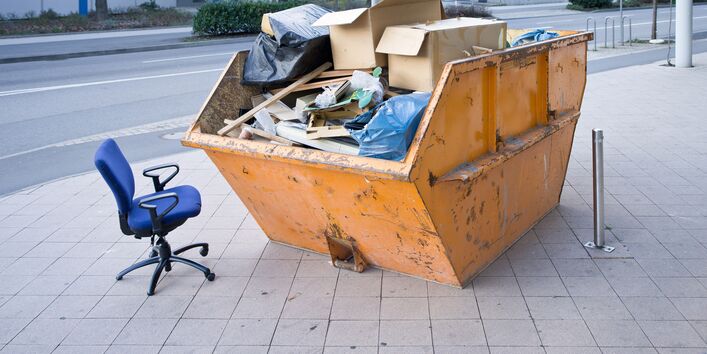Waste components and disposal
Waste regulations are intended to promote waste management, the goal being of course to conserve natural resources and protect human health and the environment through waste management. The five-level waste hierarchy in Paragraph 6 of the Waste Management Act (KrWG) defines the ranking of waste prevention and management, stating that waste should be:
1. prevented,
2. reused,
3. recycled,
4. recovered (particularly from an energy standpoint), or
5. disposed of.
By plugging the holes in recycling loops, and particularly by leveraging the recovery and recycling potential of waste, primary raw materials can be replaced and thus their use can be reduced.
The properties and composition of commercial municipal wastes (i.e. commercial and industrial wastes) are similar to those of household wastes. Such wastes can be collected separately from household wastes (in swap containers) or together with household wastes as so called “business waste” (in containers that are emptied). The Gewerbeabfallverordnung (GewAbfV) regulation governs the handling of these wastes and lays down the requirements that must be met for high-quality recycling of these wastes.
No separate statistics are available for separately collected commercial waste. According to the Abfallentsorgung statistics issued by the Federal Statistical Office (Statistisches Bundesamt), in 2010 around 3.45 million tons of mixed commercial municipal waste, three million tons of mixed construction and demolition waste, and 2.35 million tons of mixed packaging waste were trucked to waste processing facilities.
Disposal of mixed commercial municipal waste has always been and continues to be a matter of debate in the field of waste management, primarily due to the lack of data and knowledge concerning these quantity and resource relevant wastes. There appears to be room for improvement in the various disposal techniques, from an environmental protection and resource conservation standpoint. To this end, researchers have compiled the available data and information concerning the composition, quantities and disposal structure of wastes. Recyclable paper and board, wood, plastic and metal account for 52 percent of mixed commercial municipal wastes. But because only 43 percent of Germany’s 6.4 million tons of municipal waste is currently trucked to mechanical pretreatment facilities, where the waste is often sorted in the “simplest fashion,” only 16.5 percent of the recyclable elements are actually recovered from such waste, via the sorting process.
In view of the estimated 460,000 tons of recyclable materials that are recovered via the sorting process and the actual amount of recyclable materials contained in waste, it is safe to assume that anywhere from 1.1 to 3.2 million more tons of recyclable materials could be recovered through waste sorting. Recycling of the lower figure, 1.1 million tons, equates to around 13 kg/E*a. Using this data as a starting point, solutions aimed at leveraging this optimization potential have been developed, and possible amendments aimed at optimizing the Gewerbeabfallverordnung regulation have been drafted. For results in this regard, click on “Aufkommen, Verbleib und Ressourcenrelevanz von Gewerbeabfällen” (Production, destination and resource relevance of commercial wastes).
Through a UFOPLAN project, we are involved in efforts to resolve the issue as to whether recycling or energy recovery of the plastic, paper and board and other substances contained in mixed commercial wastes is preferable from an ecological standpoint. Information concerning the project, which got underway in 2012 and will end in 2014, is available under “Projektdarstellung” (Project description).

